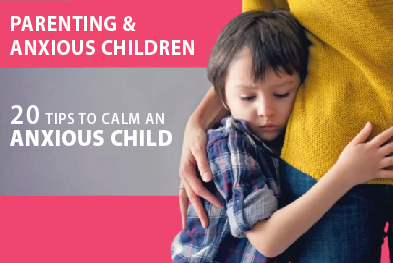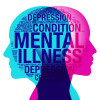
Written By:
 Dr. Ambika Kapoor
Dr. Ambika Kapoor
 Dr. Ambika Kapoor
Dr. Ambika Kapoor
Published On: 26 Mar, 2021 1:31 PM | Updated On: 09 Jan, 2026 1:49 AM
20 Parenting Tips To Deal With An Anxious Child
Intoduction-
Fears and worries, sadness and hopelessness are the normal emotions in children and adolescents.
Sometimes, they may also experience such strong emotions during their development. But the real concern arises when these fear forms become persistent or extreme.
Anxiety in the children can be explained as the many fears and worries which interfere with the school, home, or play activities of the child. It can be seen in many forms as-
• Separation anxiety-fear of being away from parents
• Specific Phobias- fear from many things or situations as lightning, thunderstorm, insects
• Social anxiety- fear of public
• General anxiety- fear about bad situations
• Panic disorder- fear manifesting other symptoms like heart pounding, sweating, breathing difficulty, and dizziness.
Presentation of Anxiety in Children-
Anxiety makes children irritable and angry. It can also interfere with their sleep and activity. One can notice the signs of fatigue, headaches, or stomachaches in such children.
Why do some children suffer from anxiety?
The exact reason is still not known, but it is said that many factors may play a role in making a child anxious.
Children are more likely to develop anxiety if they had experienced some episodes of trauma or stress, maltreatment, bully or rejection by other children, or when their parents have anxiety or depression.
When should you seek professional help for the anxious child?
It is always advisable to seek an expert opinion and to see a physician if you notice anything unusual in your ward. Early detection will lead to early cure and improved quality of life.
There is evidence that childhood anxiety disorders are at the outset of a “cascade of psychopathology,” therefore, there is a need for early recognition and treatment.1
- See your physician if the fearfulness of the child interferes with the household and family activities and life.
- When this episode frequents multiple times a day or week.
- When you notice that the frequency and intensity of the fears are increasing with time
- If your child is showing avoidance behaviour. Like refusal to attend a school or other circumstances that may provoke anxiety.
- If the child is showing isolation behaviours, not making friends etc.
- Consult your physician if you see drastic changes in his sleep pattern.
- ell your physician about any compulsive behaviour you notice in your child as checking things repeatedly, frequent washing of hands, spending more time in the washroom etc.
- Visit your physician immediately if your child suffers any episodes of panic attacks featuring heart palpitations, sweating, nausea, hyperventilation etc.
Treatment options for anxiety and depression in children
Seeking expert advice from a healthcare provider such as your child’s primary care provider, or a mental health specialist, is a must if you find your child in the aforementioned situations.
The healthcare provider can divide the management of the anxious child into two parts as- medication (anti-anxiety or antidepressant) and Behavioral therapy. Every child has different needs. The therapy may include child therapy, family therapy, or a combination of both.
Older children are introduced to Cognitive-behavioral therapy that helps them to shift the negative thoughts into more positive ones, effective ways of thinking, leading to more effective behaviour.
Behaviour therapy for anxiety may involve helping children cope with and manage anxiety symptoms while gradually exposing them to their fears to help them learn that bad things do not occur.
Other important components of anxiety management include giving nutritious food, encouraging physical activity (at least 1 hour a day), advocating sufficient sleep (as per age), having predictable routines, practising relaxation exercises and rendering social support.
Note that the following situations cannot be considered as anxiety and are part of normal child development.
• Fear in toddlers, when separated from their mother.
• Fear in toddlers in new surroundings or situations.
• Fear in 3-4 years olds of the dark, monsters, insects.
• Fears among older children of injury and death.
• Anxiety in older children while presenting their book report.
These are only circumstantial and do not need ant medical treatment. Although if you notice at any time that these activities are greatly impairing your child’s function or causing severe distress and/or avoidance, an anxiety disorder should be considered.
Parent’s Involvement in management of Anxiety in Children-
It is well said that learning starts at home. If you notice anxious behaviour in your child then you must put some efforts to calm this emotion in your child. Parents can be of great help to the children to overcome their fear and lead a happy and non-stressful life.
Lebowitz et al., in their study, compared the efficacy of the child-based cognitive-behavioural therapy (CBT) and Supportive Parenting for Anxious Childhood Emotions (SPACE). They concluded that SPACE is an acceptable and efficacious treatment for childhood anxiety disorders, is non-inferior to CBT, and provides an alternative strategy for treating anxiety in children.2
Thus, the active involvement of the anxious child’s parents and family plays an important role in the treatment of anxiety disorder.
Here are a few of the ways that may help your child overcome the fear and improve his/her behaviour-

1. Labelling and distancing- the more your child speak about the fear, the more he/ she will be out of it. Ask them to personalize their fear by making a figurine of it and providing it with a name. Bring it to life. Use any plush toy to resemble his/her fear monster. Remind them in anxious situations that he/she is superior to it. This helps children to clear their outlook about the fear they have and how to fight it.
2. Keep a positive attitude- Children often follow what they see. Try to handle the overanxious reactions calmly. Assure your child that you understand their problem and will help them out to overcome it.
3. Give Exposure- don’t try to avoid the situations your child fears, rather make them accustomed to it gradually. Like if they fear public places, take them out to some less crowded place initially and then proceed to the larger gatherings.
4. Permit distress- allow your child to use a distress tolerance tool to blow off anxious energy. As climbing stairs up and down, recognizing shapes in the living area, recognizing colours in his/her dress etc.
5. Don’t practice avoidance. Avoiding fear can rather appear as a mountain before them at some point in time. Help them to handle the situation by explaining to them the positive attitude they can show during the anxiety episodes. Also, don’t accommodate the child’s anxiety; it can be very damaging in the long run. Instead, try to calm them down and think of ways to fight it back. Like if a child is shy about speaking up in the public, never speak out for them. Rather encourage them to say something and appreciate their efforts afterwards.
6. Hear them out. It’s important to learn about the child’s feeling and anxiety states. The more you will explore, the easier it would be to fight back. Discuss the situations with your spouse too. The combined efforts of the family will make it easy to handle.
7. Don’t reassure your child about the fear of not being there, instead help your child to figure out the fear and fight it. Take deep breaths with him/her. Relax yourselves. Understand his/her concerns about the fear and help them to find the solution to fight it out.
8. Help your child know that worry isn’t that bad. Teach them that worry is a protection mechanism of the body. It keeps us alarmed and alert. It is normal to worry and it protects us from the fore coming dangers. Sometimes there are false alarms of worry (anxiety) but that can be handled with ease.
9. Teach your child to debate with themselves about the fear they have, discuss the supporting and contradictory shreds of evidence of that fear. Like if he fears going to public places, tell him/her judge between the shoe he/she lost in the fare and the enjoyment he/she had in the fare. Having a debate with themselves about their thoughts will help them to overcome their fear and grow a positive attitude for it.
10. Schedule their worry time into fun time. Let your child write down about their worries on a piece of paper and throw it away in the garbage.
11. Don’t tell your child not to worry but assign a fixed amount of minutes for them beyond which worrying should not exceed. Examples set a timer for 5-7minutes for them and tell them to hypothetically keep it in the box after that and forget for a day.
12. Help them to stay focused on the present and not to worry about future happenings. Most of the fears have the nature like- what if? This time travel takes them to another world of fear. Assist them to convert their thoughts from what if to ‘’what is’ by advocating mindfulness and breathing exercises.
13. Try the laddering technique. Instead of taking your child away from the fear, make them accustomed to it slowly and steadily. Like if he/she fears swing/ slide don’t make them sit forcibly. Instead invest some time watching other children enjoy the ride, talk about the enjoyment they are having, slowly make them watch that every day, bring them near to it in the upcoming days and finally make then sit and enjoy the rides.
14. Don’t avoid the anxiety triggering agents of your child. Instead of withdrawing your child from the fearful activity, encourage them to talk about it and learn about it slowly. Teach them the positivity of the things, which will help them be familiar with the thing thus reducing fear.
15. Prepare a checklist of the methods to calm them down during episodes of anxiety. Take handy hardboard and mark it with the breathing exercises, evaluation methods and fight methods they need to follow during their anxiety situations. This will assure them that they are ready to fight the fear.
16. Keep your attitude positive and supportive of the child. This will ensure them they have someone with them to fight against the evil.
17. Have faith in yourself. It may be saddening and frustrating for the parents to see their child’s behaviour but remember it’s the combined efforts of the child and the family that can help them out to cope up with the situation. Never blame yourself for your child’s anxious condition. Although genes, temperament, environment, traumatic experiences may be the factors for making the child anxious it’s not justifiable to blame oneself. Rather, it is best for the child and the parent to work together to come out of the situation and lead a happy and peaceful life.
18. Give them age-appropriate information. Advocating half or voided information can make them fill the gaps by their imagination which may be inappropriate. For example, just telling them- ‘Don’t go near the bushes’ can make them think of innumerable situations that can happen near bushes and make them anxious.
19. Never give them false assurance about the things they fear. Be honest with them. Like if they fear seeing the doctor for vaccination, don’t tell them that “the injection won’t pain”. Rather assure them saying that- ‘it may hurt a little like an ant bite but you are brave and strong to fight that little pain’.
20. Practice look and learn the method. Siblings/ cousins/ friends can be of great help to fight a situation. If a child fears a particular thing, watching his/her sibling/cousin doing that may provide the strength to fight their fear. Like if a child fears cycling, that watching his/her sibling cycling can decrease their fear.
Be responsible but not fearful-
With the availability of works of literature, over the past few decades, childhood anxiety disorders have made significant advancements, both in terms of awareness and treatment.3- says Muris P and Broeren S.
Although dealing with anxious children may be frustrating for some parents but they need not be fearful. With the advancements of the knowledge about the management of the anxious child, it is easy to take them out of the situation and gift them a happy life.
KEY POINTS-
The first and foremost sign of anxiety disorder in children may be a refusal to attend school due to any somatic complaints.
Diagnosis of Anxiety disorder is clinical and is to be done by the healthcare provider.
Parents and family of the child plays an important role in the management of anxiety disorder in children.
Positive attitude and gradual exposure helps to a great deal in handling anxious children.
RESOURCES-
1. Bhatia MS, Goyal A. Anxiety disorders in children and adolescents: Need for early detection. Journal of Postgraduate Medicine. 2018 Apr-Jun; 64(2): 75–76.
2. Lebowitz, E.R., et al. (2020) Parent-Based Treatment as Efficacious as Cognitive-Behavioral Therapy for Childhood Anxiety: A Randomized Noninferiority Study of Supportive Parenting for Anxious Childhood Emotions. Journal of the American Academy of Child and Adolescent Psychiatry. 2019 March.
3. Muris P., Broeren S. Twenty-five Years of Research on Childhood Anxiety Disorders: Publication Trends Between 1982 and 2006 and a Selective Review of the Literature. Journal of Child and Family Studies. 2009 Aug; 18(4): 388–395.
4. Elia J. Overview of Anxiety Disorders in Children and Adolescents. MSD Manual. 2019 May.
5. Jaworski M. Helping Kids with Anxiety: Strategies to Help Anxious Children. Psycom. 2021 March.
6. Jain R. 9 Things Every Parent with an Anxious Child Should Try. GoZen. 2018 February.





.jp.jpg)










Please login to comment on this article